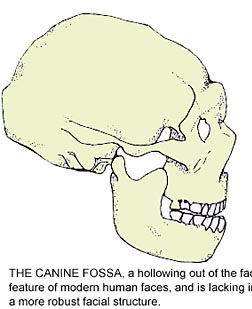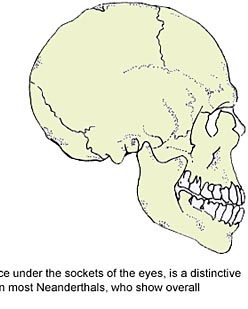
ANTHROPOLOGIST
Robert Franciscus of Stanford University has been studying the Neandertal
face for more than a decade, trying to understand its unusual architecture.
He specializes on the nasal and facial anatomy of Neandertals, and
on what we can learn about human evolution from them. (To his embarassment,
a colleague approached him at his first scientific conference and
said, "Hey, you're the nose guy!") To fathom why Neanderthals had
this combination of features, Franciscus says you need to look at
what Neandertals did with their mouth--besides eat.
Although Neandertals manufactured a wide variety
of stone tools, from heavy hand axes to delicate blades, the mouth
was a key supplement to their tool kit. From microscopic grooves
and wear patterns on Neandertal teeth, scientists conclude that
the mouth doubled as a vise for gripping the end of a stick while
the hands shaped the other end, and as a tanner's mallet for softening
and working animal skins. Straight scratches on the front teeth
suggest that Neandertals held food in the mouth while cutting it
with stone tools. Continual heavy use gradually eroded the teeth,
so that "by the time Neandertals reached their late 30s and early
40s, their teeth were worn down to essentially nothing," Franciscus
says. Only smooth nubs projected beyond the gumline.
Hard, frequent biting may have created another,
more serious problem: strain on the facial bones. According to anthropologist
Yoel Rak of Tel Aviv University, the Neandertal face represents
an evolved solution for dissipating this stress. Over many generations,
he says, the bones of the face and jaw became thicker and larger
in response to the strain from biting. This shoved the face forward.
Rak likens the Neandertal face to a pair of swinging doors that
had been pushed partway open. His hypothesis, which he set forth
in a 1986 paper, also explains the large Neandertal nose: as the
face got bigger, the nose enlarged along with it, just as a nose
painted on a balloon would grow as the balloon filled with air.
One skull feature to which Rak called attention
is the canine fossa, the hollow just below the human cheekbone.
It's absent in Neandertals. (No Neandertal could ever achieve the
sunken-cheeked, fashionably starved look coveted by today's models.)
Instead, a wall of bone continues straight down to the teeth--an
arrangement Rak claimed strengthened the upper jaw.
However, Franciscus points out one implausibility
in this adaptive story. For natural selection to favor a stronger
face, weaker-faced Neandertals must have paid some penalty in survival
or reproduction--say, they often fatally shattered their skull while
working a stick or gnawing a skin. If Neandertals--or their ancestors--did
regularly suffer this kind of injury, the fossil record shows no
trace of it.





